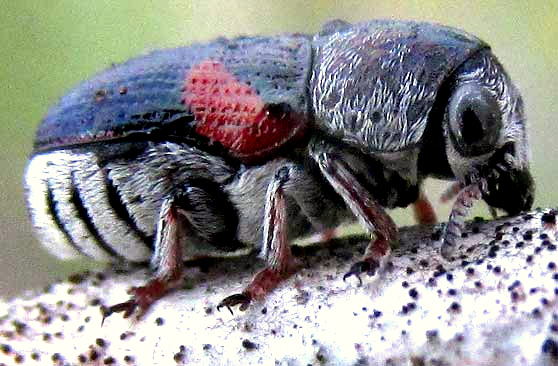Excerpts from Jim Conrad's
Naturalist Newsletter

from the February 15, 2015 Newsletter issued from Río Lagartos, on the Yucatan Peninsula's northern coast (~N21.60°, ~W88.16°), Yucatán state, MÉXICO
CASE-BEARING LEAF BEETLE
On a Bull-horn Acacia's oversized thorn, a tiny bug about 3.5mm long (1/8in) caught my eye because he was a black speck on a large, whitish thorn, plus he displayed a curious, dumpy shape bringing to mind a minuscule hippopotamus. Only beneath the hand lens were his unusual features apparent. Above, you can see his goggly compound eyes, doglike snout, partial covering of white hairs and snazzy red side-patch.
A shot from above displaying his blunt head and rear end is shown below:

With membranous wings folded beneath hard, black "elytra," which are modified front wings, obviously we had a beetle. But, beyond that, since about 375,000 beetle species are known and this was such a wee critter, what hope could we have of getting an identification, so that the creature's story could be learned? On the other hand, this was such an idiosyncratic-looking species that maybe there was hope. I shipped the picture off to volunteer identifier Bea in Ontario who after two days of her best sleuthing couldn't get anywhere. Later we realize that we both were erring in assuming that with such a long "snout" it was a kind of weevil.
Finally a website in Spanish dedicated to New World beetles was discovered, and with little hope of a reply I sent our picture to the site's producer asking for help. The letter went to a museum in the town of Curicó, Chile, and the entomologist Juan Enrique Barriga-Tuñón.
At his website, what a pleasure to glimpse the beetle-appreciating world at the museum, where over 600,000 specimens are mounted or preserved in alcohol -- and 300,000 await consideration. A page with evocative images of old-time naturalist deeply involved with what fascinates and charms them is at http://www.coleoptera-neotropical.org/8b-colecc-JEBC/JEBC.html.
Overnight Juan replied that we had a member of the Family Chrysomelidae, subfamily Cryptocephalinae, tribe Clytrini (Megalostomini), probably the genus Euryscopa or Coscinoptera. With this guidance, Bea came up with three possible IDs. After a lot of my own slogging through the literature, I'm fairly convinced that one of her names fits our little beetle. It's COLEOROZENA PILATEI. Coleorozena pilatei is distributed from southern California, Nevada, Utah and Texas into southern Mexico, and typically associates with members of the Bean Family, such as the acacia on which our beetle was found.
Species like Coleorozena pilatei are too obscure to have common names. However, the Beetle Family to which the creature belongs, the Chrysomelidae with over 35,000 known species, is called the Leaf Beetle Family, and species in the subfamily to which it belongs, the Cryptocephalinae, with about 350 species in 22 genera, are referred to as Case-bearing Leaf Beetles. So, "Case-bearing Leaf Beetle" is about as close as we can come to an English name for our little discovery. Leaf beetles generally eat vegetative material.
Case-bearing Leaf Beetles get their name from the behavior of their larvae, which carry around cases of waste material. The case begins when the mother wraps plates of fecal material around each egg. When the larva hatches from the egg, it extends it head and legs from an opening, flips the case over its back and crawls away. As the larva grows, the case is enlarged with more of the larva's own waste. Eventually the larva pulls itself back into the much enlarged case, seals off the opening, and pupates inside. When the pupa metamorphose into an adult, the beetle abandons its case, feeds, mates, and the cycle starts all over again.
I still can't shake the feeling that our beetle looks like a weevil. The first thought is that it might represent a kind of evolutionary bridge between "normal" beetles and weevils. However, since Case-bearing Leaf Beetles and weevils belong to different "superfamilies," it's more likely that our beetle's similarity to weevils is a matter of "convergent evolution" -- fairly unrelated species evolving similar features because they are both evolving toward the optimum form for exploiting similar niches.